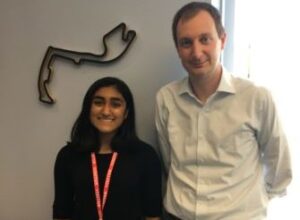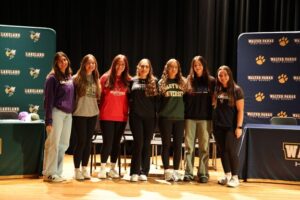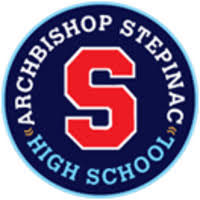Thanks to the generous support of Regeneron, each quarter, a local high school student with a passion for science will be paired with a Regeneron scientist so they can learn what it’s like to put STEM education to work in the real world. The River Journal would like to thank Regeneron for opening their doors – and labs – to future scientists from the River Towns.

Dr. Christos Kyratsous sat quietly at his desk, tapping his foot as he stared out an illuminated window, pondering his next steps. Kyratsous is leading multiple projects, ranging from gene therapies to development of antibodies to treat infectious diseases, including Ebola. It was the virus that ravaged West Africa during the 2014 outbreak, and while he hoped that his drug would be used to save lives, he also prayed that it would not need to be used again.
Gene therapy is the process of delivering genetic material (like DNA) for therapeutic purposes. Genes are often inserted inside the shells of viruses, and injected into the body. Although the process sounds awfully similar to harmful viral infection, the viruses used for gene therapy don’t cause disease and are amongst the most efficient methods of disease treatment today. Scientists like Kyratsous are using viruses to combat diseases, rather than infect and cause disease. One of the biggest benefits about gene therapy is that it often only needs to be done once. Once the DNA has found its place in a patient’s cells, it can become a part of their own genome. How’s that for a taste of one’s own medicine?
I was fortunate enough to meet Kyratsous, and interview him about his work and overall experience at Regeneron. In addition to his gene therapy work, he also talked to me about his breakthrough with Ebola treatment using monoclonal antibodies, called REGN-EB3. He told me that the Regeneron team worked tirelessly to get the investigational medicine to people in need during the current Ebola outbreak. Despite the millions of miles separating the creation and implementation of the drug, Kyratsous reflected on the urgency and importance that he feels in his work. “At the end of the day, everyone is here to make an impact, no matter what part they play,” he said.
STEM fields are reaching a place of increasing prominence in education systems globally, and I feel that Regeneron is very encouraging towards curious students who hope to go into STEM careers. Not only do they sponsor the Regeneron Science Talent Search, the most prestigious math and science competition for high school seniors in the U.S., but they are very supportive of their employees investigating beyond a strict structural process. Whether it be out of humanitarian desire or curiosity, science provides a very effective venue to leave one’s impact on the world.
For Kyratsous, love of his work stems from his curiosity. “Research is a place where I can run my imagination wild,” he said. Although the work can be difficult and requires a great deal of heuristics, Kyratsous finds great reward in the fact that he can answer questions of his own interest, while pushing for a better future.
Although I learned about REGN-EB3 from Kyratsous, I also learned to stay curious. To stay hungry. To hold on fiercely to the passion to better the world.
Eesha is a junior at Irvington High School. She’s a member of the National Honors Society, a league champion in both the High Jump and Pole Vault and an area all-state orchestra violinist. She’s passionate about science and was the 2017 runner-up in BASF’s You Be the Chemist Challenge.






